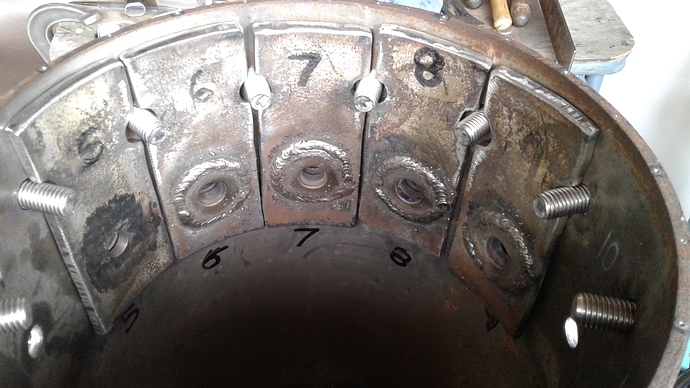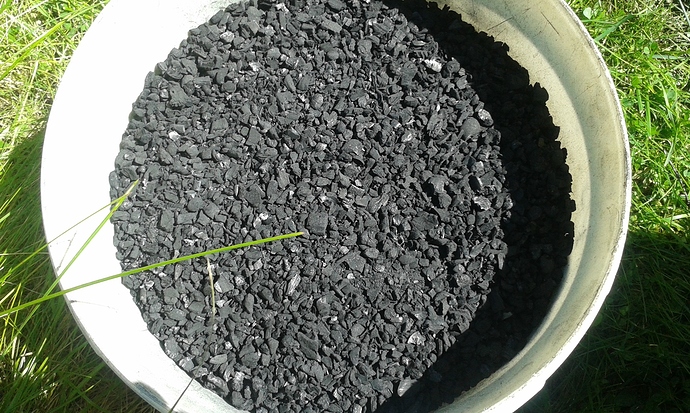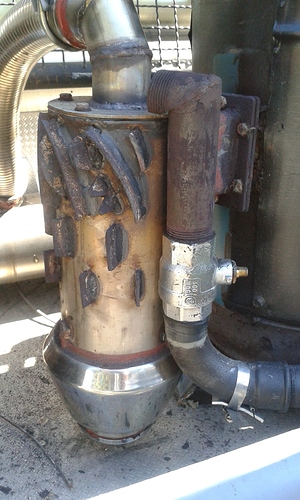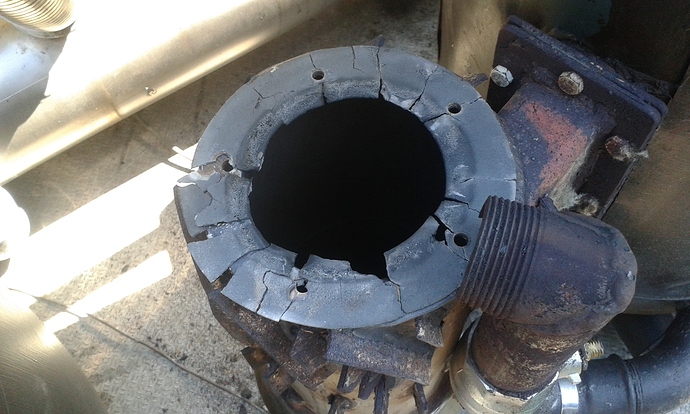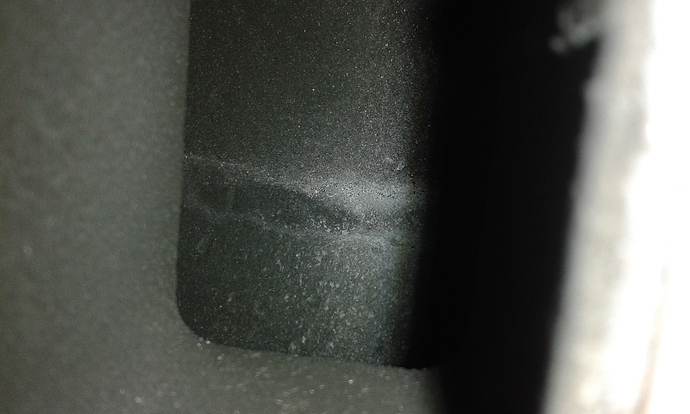Thanks JO. Beautiful country indeed, neat and clean looking. Lots of water and one lane bridges? A conspicuous absence of pick up trucks on the road, In rural Arkansas, we must be 40% pickups, most are 4x4 too.
Until the 60s-70s they were the main roads. Widened 1000 year old foot- and horse trails. Unfortunately all newer roads are widened way out into the rich soil to satisfy government’s helmet on when walking safety departement.
With annual inspections and only about 4% pickups woodgasers have a hard time here 
Here the same 
On the reduction zone, and carbons cracking waters issues I approce this from a thermal capacity modeling versus a chemical/mole view.
In the real world use this works out much better.
The the 1970’s-80’s, “The Pegusus Gasifer” (Peroleum Gasoline Substitue System) book by Danish-American
Niels Aage Skov amd Mark Papworth they state in words and maths that, " a charcoal gasifer is a Heat Surplus system . . ", " . . . a wood gasifier is a Heat Deficient system . . "
You will run out of thermal heat energy in a wood gasifier before you could ever untilize all of the wood fuel and air inlet moisture’s loading.
Dry fuel, fuel de-hydrogen un-loaded, and fuel de-oxgenated charcoal gasifier you actually can use introduced moisture (as dry steam) to harness that systems excessive heat into an engine useable chemical energy.
Save the system materials from thermal melting down too.
Tricky, tricky to balance the systems thermal loading’s from an unloaded loafing, to fully balls-out pulled outputs.
S.U.
(edit: “balls-out” refers back to the old, old power systems with spinning fly-ball control governors)
Steve, l just have to ask… Did you eat the library? Such knowlidge is rare to find.
And l think l understand what you are saying. So why do we not combine wood with charcial? Shuld get an equalibrium somewhere on that road…
Hi, Kristijan!
23.8.2016
“Standing in”, sorry… It has been done as a mix in
Imbert types and separately in zones as in Brandt.
Better gas, but not improved economy. Better humidity tolerance.
Expensive way to handle humidity.
…and in WKs…
Hi Jan, I haven’t seen any WK threads on the DOW site that has that type of set up in the Fire tube. The new tube design that Wayne has in his V-10 and what I have in my Dakota, it would be easy to change the plates out and install plates with lower nozzles. The nozzle air channel could go down the side and that air would receive more preheat. It’s just a matter of building them. Kristijan design has had me thinking on this.
Just make plate 7 longer and put a channel covering the nozzle hole. Moving it down and out the bottom of the plate.
Move the choke plate up with the break drum and have the nozzles just above adding air at that point. Second reduction zone and then out the bottom of the fire tube to the grate. It would end up with 2 reduction zone areas. The nozzles can be made adjustable for air flow from the top. It’s all in my head how to do it, and YES I do lay awake at nights thinking about this stuff.
But first I am going to get my truck on the road and put some miles on it and become a experienced DOW driver like you and the other DOW members. Thanks you for your thread and input.
Bob
Hi Max, what do you mean by, "Expensive way to handle humidity ".
Bob
Max l wuldnt exactly say its expensive if charcoal is free. Practicality is a nother question.
Hi Bob,
I was just refering to a video where Wayne showed screening out the fines when emptying the dump and then put the charcoal back with the wood in the hopper. I think the intention was showing how to cure a loose charbed as much as a possibility to save fuel.
Edit: Might even have been your gasifier 
HI, Bobmac!
23. 0f August 2016
From a commercial perspective; charcoal has always been more expensive than woodchips or chunks.
Technically, well dried wood does not normally need mixed-in charcoal to perform well, only too damp wood may need the help of dry charcoal.
That’s my viewpoint…
Single experimental setups are not taken into account in this case.
Kristijan,
Don’t forget the reduction C + H2O = CO + H2
The more C and heat available, the higher the conversion rate, the less humidity left in the gas.
The cleaner the charcoal, is more heat available to do the high rate conversion
The higher temperature in the core, the higher the conversion rate…
The rest, as S.U. said. Its all a act of balance finding in the real world.
As you might know I’ve been discovering lack of power and even som missfireing when pulling hard lately. I’ve been blaming moist in the intake due to my tiny cooler.
Usually I can go 50 mph with ease on flat ground pulling 8/2". I now struggle to keep that speed and even losig one or two cyl when pulling hard and then higher than normal gas temp.
Last two dumps from the cyclone has had lots of white in them. Kind of in layers, black-white-black-white…At first I suspected my collector pot bottom lid seal.
I auger my char out so I can’t really tell if I have white ash there. Everything is black when it gets out, fines but mostly 1/4" char.
So I removed my cyclone preheat bucket and the cyclone to take a look into the gas housing. The seals are cracked, both on cyclone top and the inlet flange. Don’t know if that’s enough leak to cause the collected ash. But there is some white ash on the firetube wall suggesting oxygene in the gas housing. Air leak or result of pulling through? I don’t know. Time to order that inspection camera and hunt for white trails.
If there is a leak, there are only two possibilties . Dump leak or where gas housing connects to the firetube. I have two dome kind of top plates. One outer air housing dome above nozzles and one gas housing dome below nozzles. Both welded to the firetube. Will require some surgery. I hope it’s the dump.
Hi JO
That seal on the cyclone does not look well. What kind of material do you use? Looks like 800c furnace mass. I have bad experiances with that. Had it on my Seat, but cracked just like yours. On my new build l use 300c silicone for the seals, its nice and elastic althugh l hope 300+ temps dont hurt it enough to destroy it.
It’s kind of a paper material for cutting out gaskets for engines. I used silicone too when I put things back. I’ll tighten it down tomorrow after work and take a test-DOW 
That gasket looks bad, I use a bolt together 8" flange to connect lower barrel (gasifier) to the drop box heat ex. Metal to metal with regular RTV silicone. The TC in this 8" pipe will get to 1000F but the seal holds.
Not wishing you bad luck, BUT I am so glad to see that cracked gasket. Some of the last post on here I thought you were resolved to the fact that maybe you gasifier was too small and for road trips you would have to resort to hybrid. I didn’t think that was the answer for you, because it had been running so well. The comments seem to go towards RTV silicone. That is a very hot spot on mine but it is worth a try. I use a Hi-temp latex sealant for my hot areas, but I only know of one store where I can buy it. My fingers are crossed hoping for the best. TomC
Tanks Carl. Good to know. It seems the red silicone can take lot more than the 300 C it´s rated for.
